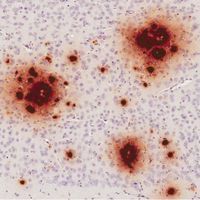Login
Subscribe404
Not Found
Is this what you were looking for?
tag prefrontal cortex neuroscience evolution disease medicine

Biological Sex Influences Brain Protein Expression
Shelby Bradford, PhD | Apr 4, 2024 | 3 min read
Neurological disorders often have sex biases, and these differences could be due to altered protein expression in the brain.

The Noncoding Regulators of the Brain
Christie Wilcox, PhD | Sep 12, 2022 | 10+ min read
Noncoding RNAs are proving to be critical players in the evolution of brain anatomy and cognitive complexity.

Natural High: Endogenous Psychedelics in the Gut and Brain
Iris Kulbatski, PhD | Sep 8, 2023 | 8 min read
Psychedelics are evolutionarily ancient compounds produced by fungi, plants, and microbes. Humans also synthesize psychedelics. Researchers want to know how and why.

Early-Life Stress Exerts Long-Lasting Effects Via Epigenome
Asher Jones | Mar 18, 2021 | 5 min read
In mice, epigenetic marks made on histones during infancy influence depression-like behavior during adulthood. A drug that reverses the genomic tags appears to undo the damage.

A Pioneer of The Multiplex Frontier
Rashmi Shivni, Drug Discovery News | May 20, 2023 | 10 min read
George Church is at it again, this time using multiplex gene editing to create virus-proof cells, improve organ transplant success, and protect elephants.

Mapping the Human Connectome
Tanya Lewis | Jul 20, 2016 | 3 min read
A new map of human cortex combines data from multiple imaging modalities and comprises 180 distinct regions.

Herpes Viruses Implicated in Alzheimer’s Disease
Anna Azvolinsky | Jun 21, 2018 | 5 min read
A new study shows that the brains of Alzheimer’s disease patients have a greater viral load, while another study in mice shows infection leads to amyloid-β build up.

Electrically Zapping Specific Brain Regions Can Boost Memory
Dan Robitzski | Aug 22, 2022 | 3 min read
Low-intensity electrical stimulation allows older adults to better recall a list of words for at least a month following the treatment, a study finds, providing further evidence for the debated idea that electrical stimulation can enhance cognitive performance.

Michelle Gray Tracks Huntington’s in Different Brain Cells
Amanda Heidt | Oct 1, 2020 | 3 min read
The University of Alabama at Birmingham neuroscientist aims to determine which cells are most important in prompting the disease’s initiation and progression.

Bacteria-Infecting Viruses in Gut Microbiome Linked to Cognition
Dan Robitzski | Feb 16, 2022 | 5 min read
Research in mice and flies suggests that bacteriophages, including those found in dairy foods, may have an influence on an animals’ ability to learn and remember information.